
Last Updated on December 9, 2020 by Jacob
Change management is the practice and art of applying organizational change and making it stick. In this article I will focus on John Kotter’s 8 step change management model, since I find this model the most universally applicable and it is covering key elements from the other most used models.
Kotter’s model is additionally “people oriented”. I particularly like this, since you can have the world’s best plan and strategy for execution, but if you miss out on engaging and understanding basic psychodynamics and driving forces of your employees, then strategy in most cases isn’t worth the paper it’s written on.
Kotter’s 8 step model for change management is one of the top 5 most recognized models / methodologies for organizational change management. Others worthy of being mentioned are McKinsey’s 7s Model, ADKAR model, Kübler-Ross model and Lewin’s model.
John Kotter’s 8 step model graphic:
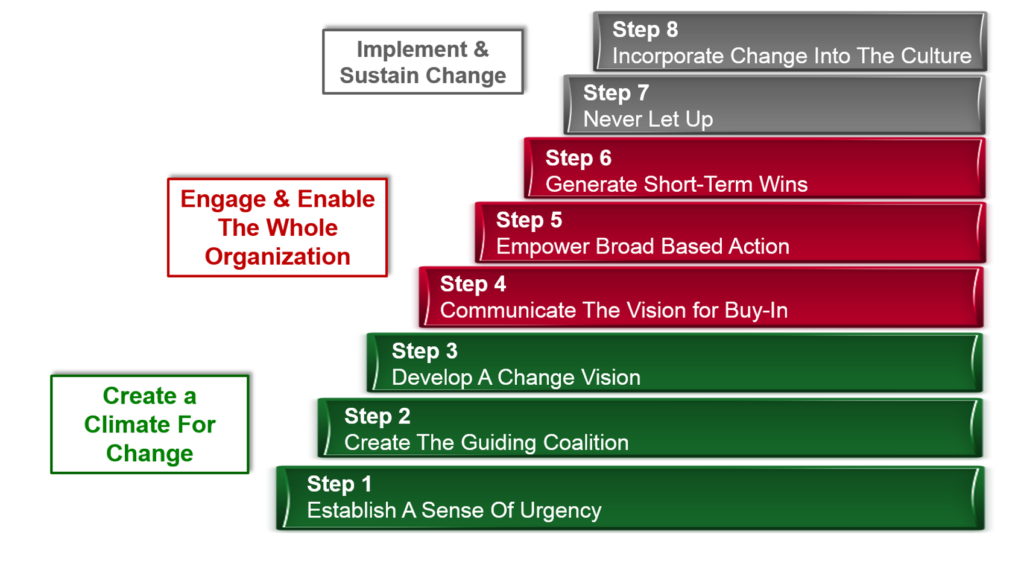
Kotter’s model is usually illustrated as an 8 step stair divided in 3 phases as seen above.
In the above 5 mentioned models there is a certain overlap. I like to draw a comparison between Kotter’s 3 phases of change with Lewin’s model “unfreeze – change – freeze” model:

Kotter’s / Lewin’s 3 phases of change:
- Create a climate for change / Unfreezing
- Engage and enable the whole organization / Change
- Implement and sustain change / Refreezing
Kotter’s 8 step model – step by step
- Create a sense of Urgency. Most people are resistant to change. If they are not given a compelling reason, most prefer to stay within their comfort zone and preferably stick to status quo. Creating a sense of urgency is also referred to as “creating a burning platform“. A burning platform is a scenario, in which employees are faced with two realities: “Change or perish”. Originally this expression comes from a North Sea oil rig fire in 1988, where workers could choose between jumping in the freezing ocean and risk the death of hypothermia, or stay on the platform and accept the certain death in the flames.
- Create a guiding coalition. The guiding coalition must be a team to guide the change within the organization. This coalition must consist of key influencing employees from all levels within the organization, including management representatives and workers “from the floor”. The members of guiding coalition must be highly supportive to the change initiative and able to influence and create support from the peers surrounding them.
- Develop an inspiring vision – a vision for change. A rule of thumb states that if you cannot explain your vision within 5 minutes and get understanding and interest from all levels of your organization, then your vision is not good enough. When creating your vision, do not only take strategy into account, but also employee’s emotions, creativity and project objectives.
- Communicate The vision – Communicating a vision happens not just with words but also in deeds. Everyone from the guiding coalition, must be able to communicate the vision and do the deeds. The vision must be communicated frequently, and it is crucial that there is full transparency about the changes being implemented.
- Empower broad based action / remove obstacles. The organization is now in the process of implementing change – but there are obstacles. This can both be in terms of old processes and procedures and about humans standing in the way of change. This step can be hard to deal with and demands tough decisions and a thorough analysis of the organization. Processes need to be changed and people standing in the way of the change / resisting the change, either have to be convinced to support the change, or ultimately have to be removed from the organization.
- Generate short term wins – Implementing lasting change can be a long term mission. By breaking down the mission of change in smaller parts and creating short term wins, you keep the organization motivated and boost morale by proving the extra work is worth the efforts. Never focus just on the end result. Recognize all small goals and achievements. This will not just keep supportive employees motivated, but also potentially have the impact to turn resisters into supporters.
- Build on the change and sustain accelleration – Kotter argues that most change efforts fail because organizations declare victory too early. Never declare victory after that first product has been launched, supported by the newly implemented change initiative. Make sure the change is rooted, by looking for improvements of the change. After that first win the organization might fall in the trap of complacency. The change has to be rooted deeply into the organization. This can happen by adapting a Kaizen mindset into the newly adapted changes, thus reinforcing the change and rewarding employees for adapting to changes and behaviours required to support the change.
- Don’t give up – Incorporate the change in the corporate culture. Changes will never happen overnight, and obstacles are unavoidable. The guiding coalition must be persistent all the time to make the change efforts go on. Make sure the implemented changes are seen on all levels of the organization, and make sure that leaders within keep supporting the change initiatives. Not only that the existing staff must keep supporting the changes, but it must also be assured that new staff brought onboard supports the implemented changes. If you loose the support of key influencers and new staff, you might end up where you started. Tips for incorporating and rooting the change:
- Include change ideals when hiring new staff and train the existing.
- Publicly recognise employees from the guiding coalition who initially made the change possible.
- Talk about the successful results as a consequence of the change every chance you get.
Most common change management mistakes
- Mistake: Allowing too much complacency and not creating a sense of urgency is by far the biggest mistake people make, when trying to change an organization. Just trying to implement change without establishing a high sense of urgency in fellow managers and employees is the recipe for failure. No matter how controversial it might sound, it can be beneficial to deliberately create a “burning platform” from within the company to facilitate motivation for change. It is as well sometimes more desirable than the alternative: Waiting for external factors such as a disrupting competitor or a financial crisis to force the corporation into adapting change, which might be at a time when it is too late to react before an undesired reality catches up. The ethics of creating a burning platform on purpose are up for discussion, but when it comes to a potential survival of a business, moral standards can sometimes be justifiably set aside.
- Mistake: Overestimating how big changes can be implemented at once in an organization and underestimating how hard it is to drive people out of their comfort zones is another typical mistake. Most people thrive in certainty and are genetically disposed to choose the path of least resistance. Some employees even favor status quo over any change thus explaining why creating a high sense of urgency is crucial for success. Without a real sense of urgency people won’t give that extra effort which is essential to make changes happen. Without a sense of urgency people are not willing to make sacrifices, and they will stick to status quo and resist initiatives from above.
- Mistake: Failing to create a powerful guiding coalition. Even in young agile organizations which seem ready for adapting change, failing to create a powerful coalition will unavoidably lead to failure. The number one mistake is management believing change can be driven by staff executives supported by the human ressource department. This is a misconception! A guiding coalition must be powerful and consist of influencing employees from top to bottom of the organization. Key influencing employees are defined not just as those who have got something to say in terms of formal authority, but also those who lead in terms of their personality, charisma and actions. The change coalition must have full support from management. Questions to ask when creating a guiding coalition:
- Are enough key players onboard, especially among those doing the work, so resisters cannot block the progress of change?
- Does the coalition possess the full spectrum of expertise needed to drive and implement the change, both in terms of leadership abilities, relevant technical skills and experience?
- Does the coalition have the credibility, reputation and respect within the organization so their pronouncements are taken seriously?
- Mistake: Underestimating the importance and power of a vision. A powerful vision plays a key role in directing, aligning and inspiring actions across the whole organization. As mentioned earlier – if you cannot describe your vision in 5 minutes and get both understanding and interest – then your vision is not good enough.
- Mistake: Under-communicating the vision by a factor of 10. Your vision is meant to guide the masses. The mission must be clear to everyone and thus be repeatedly communicated both in words and actions. The most certain way of undermining change is inconsistency between a verbally communicated vision and the actions of important individuals.
- Mistake: Permitting obstacles to block the new vision. How hard it may seem, obstacles of the vision must be cleared out of the way. This might be old tools, procedures, as well as people. If you are not able to win the hearts and minds of key influencing employees, who stand in the way of change initiative implementation, then you have no other option than to remove them, unless you want to fail. Same goes for tools and procedures.
- Mistake: Failing to create short term wins. Humans are inherently programmed for seeking some kind of gratification. Often through the path of least resistance. There’s a direct correlation between human’s ability to delay the need for gratification and future success. Nevertheless, we are all motivated by short term wins. Especially if you want to gain momentum and keep motivation in the organization as a whole, you must secure short term wins. This can be done by breaking down goals in milestones, and making sure to celebrate those achieved.
- Mistake: Declaring victory to soon and neglecting to anchor changes firmly in corporate culture. See step 7 and 8 in Kotter’s model described above for details. Deeply rooting change in a corporate culture can take at least 3 years, and until then the implementation is fragile and subject to regression.
A core pillar of change: The guiding coalition.
Second step in Kotter’s 8 step model is “Create a guiding coalition”. Even though it is described above – both in terms of purpose and pitfalls you should be aware of, I will give some additional tips. Though the burning platform, a vision and a powerful coalition are all essential pillars of change implementation, I am of the opinion, that the subject of forming the coalition is where most corporations fail.
Never forget: A guiding coalition made up only of managers—even superb managers who are wonderful people
—will cause major change efforts to fail. – John Kotter
To harness and clarify the purpose, unity & alignment of the guiding coalition an off-site workshop is recommended. This off-site session has the specific purpose of forming a cohesive team of the guiding coalition. This can be 2-5 days of planning, talking, analysing, climbing mountains and playing games to increase mutual understanding and trust within the coalition. A lot of the time should be spent on encouraging honest discussions on how members of the coalition think and feel about the the change mission ahead, with regards to the organization, its problems and opportunities.
Fictive case – SCRUM framework implementation in an IT company
I have chosen to make a fictive organizational change management case example of SCRUM adoption in an IT company with basis in Kotter’s 8 step model. I chose the SCRUM adoption, since it’s a hot topic in IT, I work in IT, and it is fairly straight forward to conclude, if you have had a successful change implementation.
What is SCRUM
Scrum is an agile lightweight framework based on empirical process control theory and lean thinking. Scrum is a framework for complex product delivery to generate value by optimising predictability and controlling risk. SCRUM consist of values, rules, events and artefacts. If you wan’t to read more on the basics of SCRUM read my article on how to pass the SCRUM master exam.
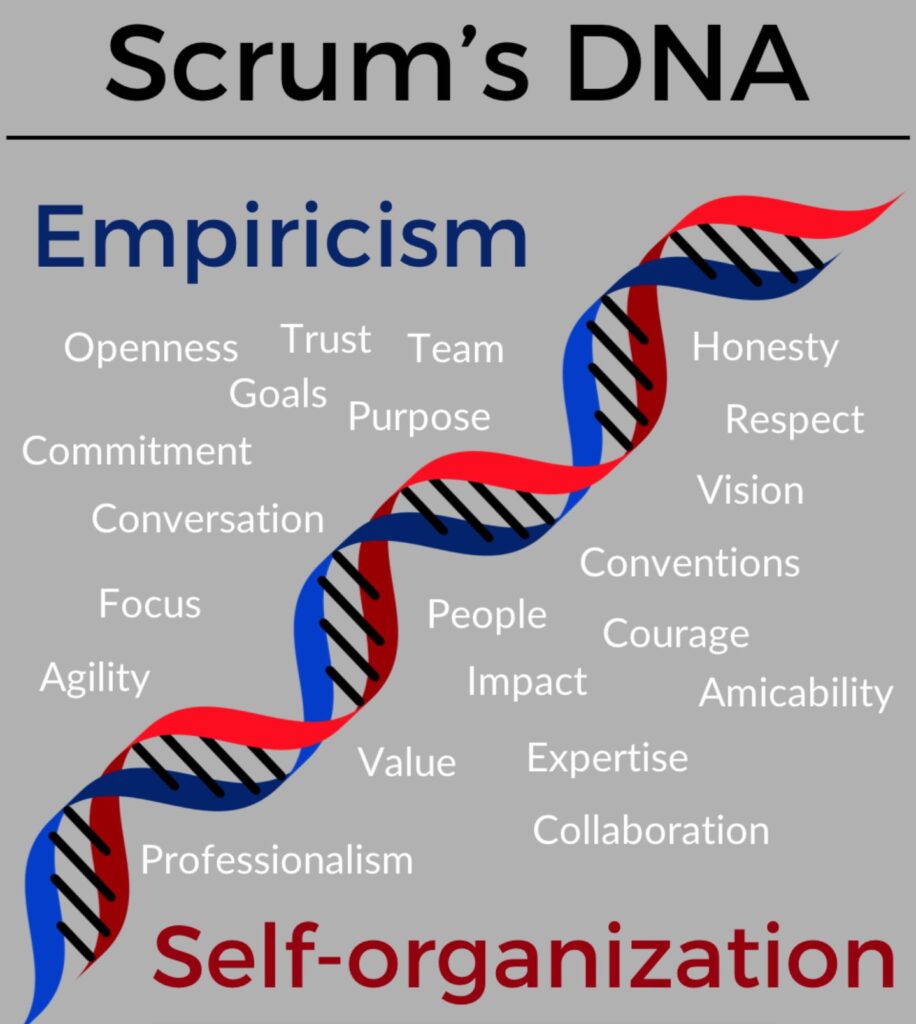
Why SCRUM
In IT, budget overrun and broken deadlines are more the norm than an exception to the rule. SCRUM offers a framework for frequent inspection and adaptation to minimise risk. SCRUM, applied in the IT industry, has often proven to give a 400% increase in value, compared to typical waterfall project mangement methodologies. Additionally SCRUM methodology is fairly simple to learn, but though difficult to master. SCRUM inherently embraces change by fostering agility and continuous improvement.
8 Steps to implementing SCRUM
To initially make it clear, what I see as the potentially biggest pitfall in SCRUM adoption, I will start quoting from the latest edition of the SCRUM guide (2020 edition):
While implementing only parts of Scrum is possible, the result is not Scrum. Scrum exists only in its entirety and functions well as a container for other techniques, methodologies, and practices. – (The 2020 Scrum Guide)
Step 1 – Create a sense of Urgency
The IT industry is by far the fastest developing industry in the world. On the hardware side, we have Moore’s law which dictates that the capacity of processors are doubled every second year while production cost is being halved. In software industry competition is everywhere and the next big disruption event is lurking just around the corner. All software companies are always facing a reality of being only few years, or even months, from going obsolete! Complacency in software industry equals certain death. No employee can be unaware that competition is an ongoing threat, not just for the next bonus pay out, but for the sole existence of the company. Depending on the mission of your company, make sure all employees are aware why you MUST succeed, and why the current way of working towards the goal must change. Give concrete examples of the past years track records. This being examples of:
- Number of missed milestones and deadlines
- Examples of products and technologies being obsolete on launch date
- Estimates on the potential size and scope of sunk cost from a financial perspective
- Estimates on the opportunity cost for running xx months/years over deadline
Step 2 – Create a powerful guiding coalition
The SCRUM framework is fairly simple to understand. One of the core concepts is that the framework, as outlined in the SCRUM guide, is “immutable”. This immutability is yet what makes the plan for implementation simple, but the reality a very different story. The adopting organization must understand the framework of SCRUM from top and bottom. If the top management does not understand and respect the fundamentals of SCRUM, or at least stick to the advices provided by a senior SCRUM master within the organization, an implementation is doomed to fail.
The guiding coalition must, in my opinion, consist of at least one top management representative, who understands the basics of SCRUM and fully supports the vision and mission of implementation. The top management representative has among other the responsibility to make sure the rest of the management respects the rules of SCRUM, supports implementation and facilitates removal of impediments on the road to fulfilling the mission.
No need to say the guiding coalition should include the SCRUM masters, but additionally the product owners, key stake holders and key influencing developers.
One of the overseen challenges of SCRUM is the need for self-reflection & self-management in the development team. Self reflection on a meta-cognitive level is hard for most people, especially when it comes to self-admittance on more sensitive topics. For the same reason I suggest that at least one HR representative participates in the guiding coalition.
As mentioned earlier in this article, the guiding coalition needs in it self to be a cohesive team bound with trust and an open and transparent way of communication.
Step 3 – Develop an inspiring vision
The vision needs to be guiding the direction, motivating, catching and evoking emotions. It should awake peoples interest and be able to be explained and understood in less than 5 minutes. With risk of putting myself on the line of fire, I will give a more generic example of a vision for SCRUM adaption:
SCRUM implementation offers a unique opportunity to excel, and utilize the best in all of us, when it comes to collaboration, intellect, creativity, productivity and continuous improvement. Time is working against us and competition is breathing down our necks. Thus we need to utilize the proven framework of SCRUM to assure a continuous delivery of value to accomplish “Project X”. To assure we are the best in class we must never settle & accept complacency. By continuously striving to be the “best in class” and living the SCRUM values, we will be one step ahead of our competition, which ultimately will secure us market dominance for the benefit of all of us.
Step 4: Communicate the vision.
SCRUM is an agile framework, but despite the agility, the values, events and artefacts are immutable, and need understanding, backup and support within the whole organization. The vision of SCRUM implementation must be clear to everyone, and it cannot be over-communicated. Suggestions for communication the vision:
- Rehearsing the SCRUM vision at every relevant opening of a meeting.
- Frequent repetition of the cornerstones of the SCRUM framework in all group meetings
- Printing posters of the vision to hang visible within the company including posters, stickers, covers etc. with the SCRUM values of “commitment, focus, openness, respect & courage”
- Voluntary SCRUM knowledge sharing work groups
- Honoring and highlighting the SCRUM values whenever possible
- Painting the “House of SCRUM” on walls and door entrances
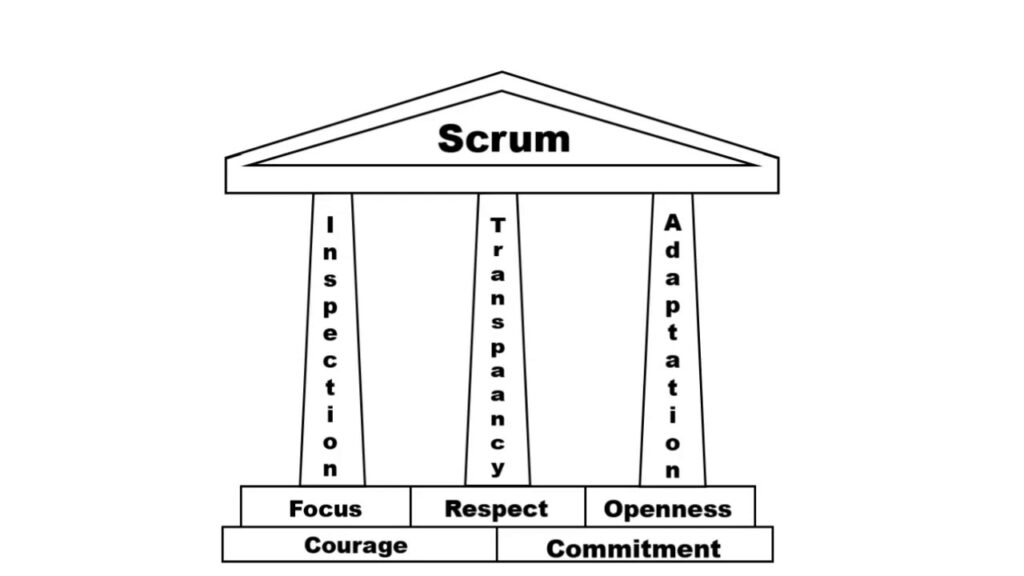
Step 5: Empower broad based action
The devil is in the details. Over time, the current structures and procedures in an organization are supporting status quo. When implementing change, you wan’t to move away from status quo, which means you must deal with tools, processes and people who do not support, or even resist change.
If the guiding coalition is chosen wisely it will consist of people with the right authority, functional expertise and organizational stakeholders. Empowering broad-based action is not just about analysing and moving impediments for change, but also about training staff to be able to support and live the change.
When it comes to SCRUM, it is pretty straight forward. Knowledge is power. Obligatory seminars for all, to understand the fundamentals of SCRUM. Additionally, all stakeholders and project managers must put all cards on the table when it comes to existing project management methodology and supportive project management software. What tools and processes are not in line with the SCRUM framework? The benefit of adopting SCRUM in perspective of change management, are the in-build SCRUM events to welcome change. Here I specifically refer to the “sprint retrospective” which is a minimum once a month event, where the SCRUM inspects itself and creates a plan to improve in the upcoming sprint.
The SCRUM masters of the organization have a crucial role in this phase, since they are stakeholders on making sure the whole organization understands SCRUM. I do think it is easy to underestimate the value of a certain seniority and expertise among at least some of the SCRUM masters. If SCRUM implementation is to be successful, the SCRUM masters as SCRUM facilitators must be the people with a certain seniority and respect within management. The managerial layer is often among those resistant to change – especially when it comes to adopting SCRUM, since it includes giving away control and authority to employees lower down in the formal hierarchy. In regards to SCRUM the most acknowledged challenge is the Product Owners being “feature creeped” and overruled by management or external stakeholders, leading to disruption of flow and the inbuilt value optimising eco-system of SCRUM.
Step 6: Generate short term wins
Generating short term wins in SCRUM is straight forward. Short term wins are equal to a continuous delivery of value – which is the essence of SCRUM. The cyclical incremental delivery of value, with sprints containing daily scrum, sprint planning, sprint reviews and sprint retrospectives, offers a unique opportunity to create short term wins. As soon as the first product increments are released timely and successfully – it is important it is known and celebrated within all relevant parts of the organization. Same goes for burn down charts. Staying on track in the burn down (or burn up) chart, can in itself be a measure of success – and if sprints are planned as one month sprints, it gives a monthly opportunity for celebration. The sprint retrospective within SCRUM is the SCRUM team’s formal event to discuss and plan improvement – and even in the case a sprint didn’t turn out as planned, later successfully implemented improvements, can be declared as a win. Adopting the Kaizen mindset is a win in itself!
Step 7: Never let up and build on the change
If SCRUM is successfully adopted in the organization step 7 is “self-serving” as per the in-built continuous improvement aspects of SCRUM. The Sprint Retrospective is the very last step – “time boxed” for 3 hours for a 1 month sprint or 45 minutes per week of planned sprint.
From the 2020 SCRUM guide – Sprint Retrospective:
“The Scrum Team inspects how the last Sprint went with regards to individuals, interactions, processes, tools, and their Definition of Done.”
There are countless methodologies to facilitate a sprint retrospective. A more “industrial” approach could be to let you inspire from a PDCA cycle (plan, do, check, act):

or a DMAIC cycle (define, measure, improve, analyse, control).
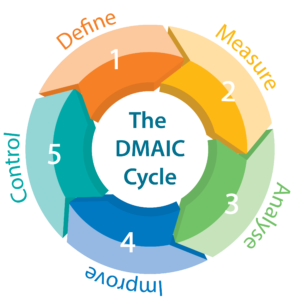
The two above mentioned methodologies for continuous improvement require quantifiable measure points, which become more difficult when it comes to the question of people and interactions. In this article I will not dig into the topic of feedback and human interactions, such as giving and receiving honest feedback and meta-cognition, but noteworthy is to assure that subjects are continuously brought up for reflection in the retrospective.
Step 8: Make it stick & Institute change
As mentioned earlier, most change initiatives fail, cause Victory is declared too soon. If not rooted in the organization, there is a probability that people will let up on the change, and return to the way they have always done. Best way on institutionalizing change is to set up criteria as SMART goals (specific, measurable, attainable, relevant, time-bound), which are all supported by management and the guiding coalition. Those SMART goals are then initially taken up at regular intervals to evaluate if the organization is still on the right path. Let’s say we have X number of smart goals as a checklist of goals everyone is committed to – if that checklist is checked off successfully every month or quarterly it can be declared that the changes have been implemented successfully. No need to say that when there is a turnover in management and general staff the VISION and success criteria for the SCRUM adoption have to be carefully revisited with all new staff.
SMART goals should not be up for dispute:
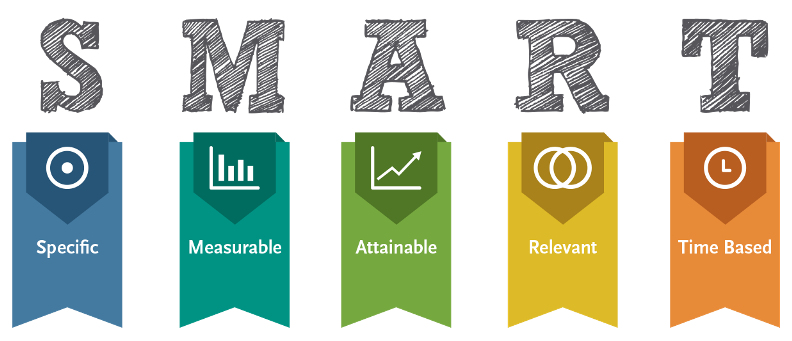
Success criteria of SCRUM adoption
Lastly, I will come up with suggestions for questions to help evaluate if you have had a successful SCRUM adoption in your organization.
- – Are all Scrum rules and mechanics in place? (3 Roles, 5 Events and 3 Artefacts with its Commitments)
- Does everyone in the company have courage to do the right thing without waiting for his/her manager permission?
- Do people inside the company communicate relevant information without regards to hierarchy?
- Are Scrum Teams self-managed, which means product vision and goals are transparent and specialists have freedom to decide about “HOW “, they improve their own processes, tools and collaboration during retrospectives?
- Are Product Owner decisions respected, and is he/she personally committed to the Products
- Is Business value delivered by products measured, transparent and does it increase with product development?
Since this article is vastly based on a fictive scenario, feel free to contact me in LinkedIn if you have comments or suggestions for improvements. I will be very happy if you do so.
